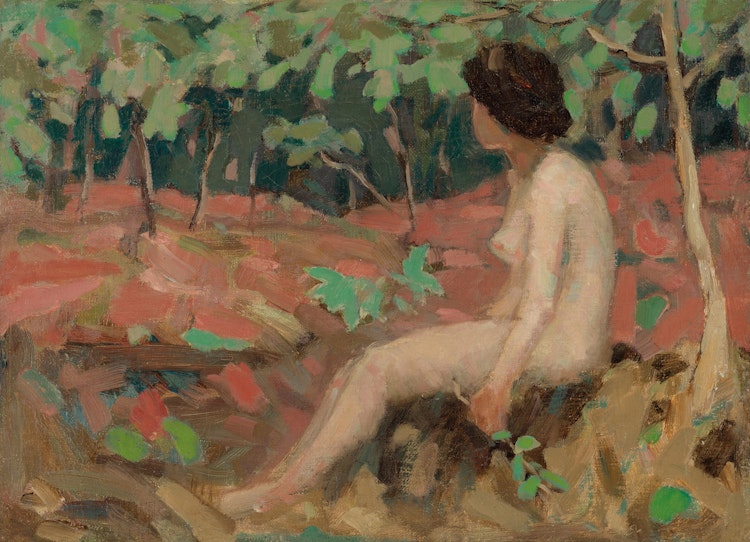Resting Nude by James Wilson Morrice




Preview this item at:
Cowley Abbott
326 Dundas St West
Toronto ON M5T 1G5
Ph. 1(416)479-9703
James Wilson Morrice
Resting Nude
oil on canvas
titled "Nude" to the gallery label on the reverse; F.R. Heaton estate stamp on the stretcher
10 x 14 in ( 25.4 x 35.6 cm )
Auction Estimate: $40,000.00 - $60,000.00
Estate of F.R. Heaton, Montreal
Continental Galleries of Fine Art, Montreal
L.M. Hart, Montreal
Private Collection, Montreal
"The Private Collection of the Late F.R. Heaton", Continental Galleries, Montreal, 22 October‒4 November 1949
"Ten Montreal Collectors", Montreal Museum of Fine Arts, 8-24 February 1952 (loaned by L.M. Hart)
"May Catalogue Show", Walter Klinkhoff Gallery, Montreal, May 1991
[Anon.], 'Fine Paintings Shown in Heaton Collection', "The Gazette" (22 October 1949), page 26, mentions "a comely nude seated in a wooded landscape"
Robert Ayre, 'Collection Here Reflects Discrimination', "Montreal Star" (15 February 1952), page 32, "mentions a nude in Hart collection"
Lucie Dorais, 'Morrice et la figure humaine/Morrice and the Human Figure', in Nicole Cloutier, "James Wilson Morrice, 1865-1924", Montreal, 1985, page 69
Morrice painted his mistress Léa Cadoret, his friend Robert Henri, (likely) Henri Matisse and William Brymner in the mid-to-late 1890s, all in small format oil sketches, which are more spontaneous than large, carefully planned canvases. Numerous sketches of female models fill his sketchbooks from 1895-1898. Robert Henri wrote to his family that Morrice had painted several very beautiful portraits of models during the autumn of 1898. At about the turn of the century, Morrice seems to have lost interest in the study of the human figure as a stand-alone subject. His landscapes, meanwhile, became increasingly animated by human activity, and many of the oil sketches of this period show people sitting in cafés. The subject of nude and clothed models was revived somewhat around 1908, when he presented one at the Salon d’automne in 1908. The brighter palette of his portraits of the years to come were likely influenced by the colourful work of Pierre Bonnard and Henri Matisse.
Author Lucie Dorais has remarked on the link between the artist’s figural work and his own character, writing: “All of Morrice’s portraits, whether they represent friends or professional models, bear the stamp of his reserved disposition. The models are almost always seen from a distance, sometimes in profile, and most of the nudes have their back to the spectator. The artist, who was extremely shy, perhaps wished in this way to avoid any interference from the subject, so that he could concentrate on his aesthetic preoccupations, especially the harmony of colour tones.”
We extend our thanks to Lucie Dorais, Canadian art historian and author of "J.W. Morrice" (1985), for assisting with the research on this artwork.
Register to Bid
To participate in our auction by telephone or absentee bid, please register below. You may also download a bid form and email a completed copy to [email protected] Bidding registration must be submitted by 12:00 Noon ET on Wednesday, May 28th.
Bid in Person Telephone Bid Absentee Bid Download Bid Form
Already have an account? Sign-In
Register to Bid Online
To register to bid online during our live auctions you will be taken to a different website hosted by Auction Mobility. A new account, separate from your regular Cowley Abbott Client Profile, will need to be created prior to online bidding registration.
Bidding registration must be submitted by 12:00 Noon ET on Wednesday, May 28th.
Please Note: All bidding through the Auction Mobility site and apps is subject to a 21% Buyer's Premium
Get updates or additional information on this item
Watch This Item Ask a Question Request Condition ReportShare this item with your friends
James Wilson Morrice
(1865 - 1924) RCA
Born in Montreal to a prominent family of textile merchants, Morrice spent most of his life abroad, much of it in Paris. He had gone there to enrol in the Academie Julian, the best-known of the private art schools that lured dozens of young Canadian artists to cross the ocean with the promise of technical proficiency and stylistic sophistication. Soon Morrice was studying with the Barbizon painter Henri Harpignies and looking intently at the pictures of the cutting-edge Nabis members. Affable and gregarious, Morrice was well liked in Paris among the local and emigre vanguard, notably his friends the great Henri Matisse and the influential American painter Robert Henri. He did well, showing in the most prestigious exhibitions of new art, including the Salons, and selling to discerning European collections of the highest rank. If he is remembered mostly in Canada today, it may be because Canadian collectors repatriated most of his pictures after his death, leaving Europeans with little to go on. He had been careful to maintain a reputation at home, showing here regularly and returning frequently for Christmas, which would explain why most of his Canadian pictures are winter scenes. Young Canadian artists held him in considerable esteem during his lifetime for his fearless modernism and his success in Europe. A stylistically hybrid artist, Morrice combined a lush and often dusky Post-Impressionist tone with nonchalant brushwork of a plumb assuredness, softening the blunt structures of his Fauvist friends. What results are paintings as complicated as they are straightforward and often redolent with suppressed emotion. Morrice tends to smallish pictures that draw you in, only to surprise you by their resolute diffidence. Irresistible and remote, his pictures ask for intimacy but keep their distance, like nostalgia, like longing. Morrice ran with a fast crowd of glittering cosmopolitans. Alcoholism got the better of him by the end of his fifties; his health ultimately failed while in North Africa where he had painted with Matisse and where he died at fifty-eight.
Source: National Gallery of Canada




